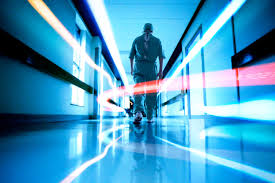
The walk from the bustling parking area to the hospital and university gate, from the happy exclamations in the lecture hall to the stifled cries of the hospital cafeteria, from the safety of the text books in the library to the rude awakening of facts presented as real life cases in the clinics – walks to remember.
As you enter the hospital gate, you see people from all walks of life. The guards, the peons, the doctors, the paramedics, the students. Everyone with a different sorrow, a different smile, a different perspective; a different story.
You wonder how many number of hours the guards spend on duty, if they have children, if they live in Karachi, or have a family surviving on their meager wages back in some small city of Pakistan. As you see the students rushing towards the university building, hand in hand with eager anticipation to become au fait with the complex workings of the human body, bearing the weight of a life-long, heavy friendship with *Robbins and *Guyton, one wonders if they are equally eager to put books and real life at a dehydrating competition. Within a few hundred yards, two conflicting emotions exist in oblivion. A striking contrast to this elucidation of youth and vitality , were the furrowed faces of the patients hurrying in for their turn. Their brows lined with worry, patience was all that they had. And a will to slander whatever ailment they were combating. You wonder how life is treating them. How their families are coping with their disease. How they are coping with their disease.
Books teach you facts and figures. Experiences teach you a lot more.
Standing behind the senior physicians, you are on a roller coaster of emotions. Grateful for this opportunity of observing what you have been taught, you are gripped by an unnerving feeling of experiencing what it actually is like, both for the doctors and their patients. Silently grateful for the blessing of good health, it is like being on an odyssey where you see one human after another, fighting to live. Here in the rheumatology department, it was not essentially a fight between life and death. It was a struggle for survival. It was a struggle to get up and walk. It was a struggle to cook your own food. It was a struggle to perform those little daily chores that we so take for granted. And admist this struggle, they were also celebrating. They were celebrating those joys of life that we usually ignore, deeming them inconsequential. And they were ready to live and do whatever they could to make their lives easy, and of those who loved them.
Managing *SLE with a positivity and a determination that was beyond impressive, a young woman presented the physician with a diary that she had been maintaining to record her condition. If that was not a reflection of her strength, I don’t know what is. And one could not, but help feel immense pride at her iron will.
Walking down the corridor of the Out Patient Department to head towards the hospital cafeteria, I often wonder whether it was scathing insensitivity or a mere coping mechanism for the preservation of sanity, that compelled me to easily locomote towards the cafeteria to satisfy another biological need – hunger. I hope the answer lies in the latter.
Wounds will bleed. People will die. But. Life must go on. You need to go on in order to ensure the continuity of life. And for that, you need not cringe at the sight of blood.
From the Earth we come, and to the Earth must we return.
Be it a walk to the hospital entrance, the pharmacy, the O.P.D., the surgical suite, the biochemistry laboratory, the anatomy museum, or to the lecture hall; each of these simple acts of locomotion are unique in itself. They are walks to remember. With open eyes and an open heart, you can grok the lessons of life, espy an ambitious, hardworking soul, intuit a loving heart.
*Robbins = Robbins Basic Pathology
*Guyton = Guyton and Hall Textbook of Medical Physiology
*SLE = Systemic Lupus Erythematosus (an autoimmune disese)